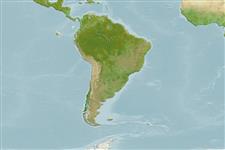Teleostei (teleosts) >
Anguilliformes (Eels and morays) >
Ophichthidae (Snake eels) > Ophichthinae
Etymology: Ophichthus: Greek, ophis = serpent + Greek, ichthys = fish (Ref. 45335); arneutes: Name from Greek meaning a diver, referring to both the depth and means of capture..
More on authors: McCosker & Rosenblatt.
Environment: milieu / climate zone / depth range / distribution range
Ecology
Marine; bathydemersal; depth range 434 - 557 m (Ref. 31243). Deep-water
Southeast Pacific: Galapagos Islands.
Size / Weight / Age
Maturity: Lm ? range ? - ? cm
Max length : 30.6 cm TL male/unsexed; (Ref. 31243)
Short description
Identification keys | Morphology | Morphometrics
Life cycle and mating behavior
Maturities | Reproduction | Spawnings | Egg(s) | Fecundities | Larvae
McCosker, J.E. and R.H. Rosenblatt, 1998. A revision of the Eastern Pacific snake-eel genus Ophichthus (Anguilliformes: Ophichthidae) with the description of six new species. Proc. Calif. Acad. Sci. 50(19):397-432. (Ref. 31243)
IUCN Red List Status (Ref. 130435)
Threat to humans
Harmless
Human uses
Fisheries: of no interest
Tools
Special reports
Download XML
Internet sources
Estimates based on models
Preferred temperature (Ref.
123201): 2.6 - 2.6, mean 2.6 °C (based on 1 cells).
Phylogenetic diversity index (Ref.
82804): PD
50 = 0.5000 [Uniqueness, from 0.5 = low to 2.0 = high].
Bayesian length-weight: a=0.00089 (0.00039 - 0.00204), b=3.00 (2.80 - 3.20), in cm total length, based on LWR estimates for this (Sub)family-body shape (Ref.
93245).
Trophic level (Ref.
69278): 3.7 ±0.6 se; based on size and trophs of closest relatives
Resilience (Ref.
120179): Low, minimum population doubling time 4.5 - 14 years (Assuming tmax>10).
Fishing Vulnerability (Ref.
59153): Low vulnerability (21 of 100).
